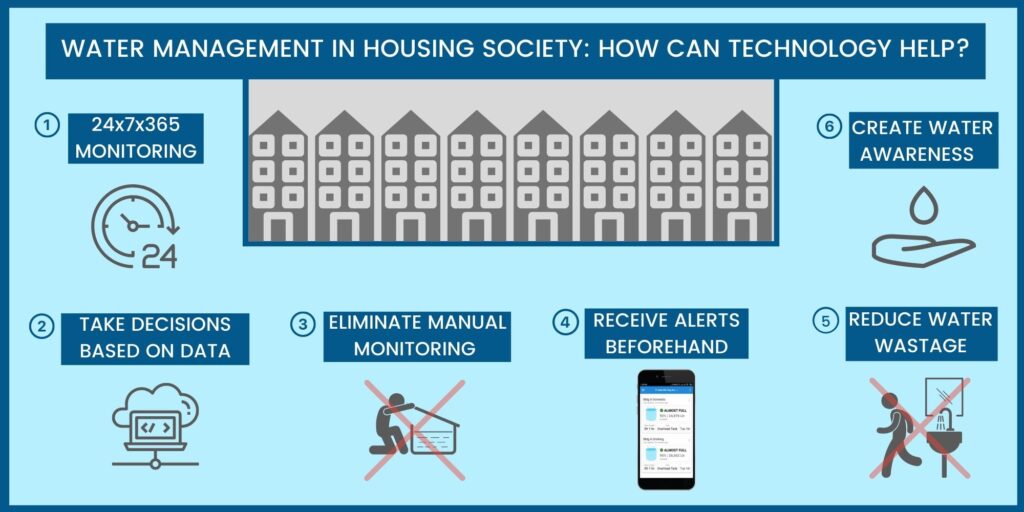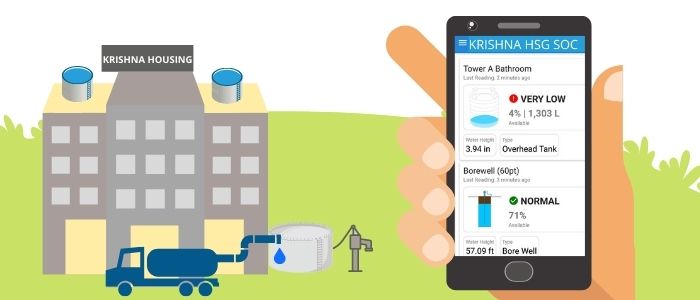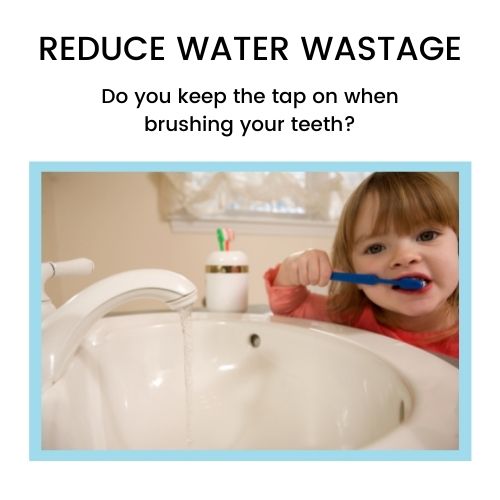IoT tech, a natural fit for Water Management
In the first part of this blog, we discussed the water management issues faced by Housing Societies. Traditional methods of water management provide inefficient and cause unnecessary water wastage and increased water consumption.
Table of Contents
Toggle
Today, we will discuss ways in which these issues can be tackled rather effectively by technology. Technology helps us track our water and data at all times. The availability of this data enables us to anticipate further issues. IoT based water management can help us solve a lot of the issues discussed in the earlier blog. Technology equips us to see the movement of our water and its consumption on a single platform.
How does technology provide a superior solution for water management?
-
Eliminates tedious manual tasks
-
Provides actual data
-
Helps to cut down on water wastage
-
Provides 24x7x365 monitoring and intelligence with IoT
Let’s break each of these down in detail.
1. Technology: Eliminate tedious manual tasks
In today’s day and age, it is tedious and completely unnecessary to have someone manually monitor the water tanks. It is unfair for the individual as well, when he could acquire higher skills and engage in something more worthwhile in his life. It also adds to your list of trivial expenditures that could be completely avoided.
Technology can cope with this matter easily. Installing digital water level sensors can help you to monitor your water tanks efficiently with minimal labor requirement. It also provides 24/7 monitoring which is hard to do manually.
Typically we see that the staff member gets busy with other work while tanks overflow or somebody is in the shower and the tap suddenly dries as the overhead tank has gotten empty.
With features such as wireless water tank overflow alarms and alerts, the need for physical surveillance reduces drastically.
Along with this, the need for risky instances such as climbing ladders on terraces in order to access water tank levels goes away.
In addition, reliable water management technology reduces the housing society’s dependence on a particular staff member and eliminates chances of human error and laziness.

2. Technology: Provide actual data
In the current scenario, since there is no data gathering taking place, it is hard to create a unified system for water management. Haphazard, reactive management of water results in a lot of inefficiencies such as water wastage and over consumption of water.
Today water management in housing societies is optimized as per the schedule of the staff member who operates the water.
He switches the pump on and off based on a predetermined timetable and does not take into consideration the actual water consumption of each tower or the volume of water available in each tank.

Plus, it is difficult to know the amount of water in your tanks by just looking into it. It is impossible to gauge the size of tank, water inlet height, location of the overflow pipe and leakages in the tank, etc.
It is a good idea to have this information handy at all times so you can plan for the future and avoid leakages and overflows. The availability of this data from various devices under one umbrella forms a cohesive water management system.
“You can see your water at all times.”
When this water becomes visible to you, you will be able to track and manage data for various activities –
- Understand the total volume of water received and consumed per tower. This gives you insight into your overall water footprint and allows you to plan ahead.
- Take proactive measures to prevent water hazards such as leakages, overflows and dry taps. Usually, such issues are tackled AFTER the problem arises. With the availability of useful data, we will be able to gauge their occurrence beforehand.
- Avoid last minute water cuts.
- Reduce overall consumption and save water in the long run.
- Book water tanker service in advance, ensuring better prices and availability.
- Create awareness in the community by publishing monthly water consumption data and motivating members to manage their water in a better way.
3. Technology: Cut down on water wastage
Are you someone that keeps the tap running while brushing your teeth?

If your answer to this question is a ‘yes’, then it is high time you monitor your water habits.
Did you know that the average Indian uses at least 80-100 gallons of water directly, per day?
Water use is growing at twice the rate of population growth per day.
Measuring your own water footprint can help us come up with strategies for sustainable water usage. Technology gives you a chance to do this.
Since your own data is available to you, you have access to your individual water pattern. You can plan accordingly by adopting simple water saving tips such as watering your garden in the evening, saving the water used for washing veggies and reusing it in the garden, using a bucket of water for your bath instead of letting the shower run etc.
Seeing our water makes us water conscious.
4. Technology: Provides 24x7x365 monitoring and intelligence with IoT
IoT refers to the Internet of Things. In layman’s terms, it is a network of physical devices such as sensors that monitor various parameters in the field (e.g., temperature, water level, soil moisture etc.) and upload it into the cloud.
Based on the information received from the sensors, the cloud algorithms determine whether the user needs to be alerted or not and send an alert to the user’s mobile or other devices.
Such a network gets more intelligent and reliable as it starts collecting more data from the field as more people start using it.
WaterApp is one such IoT based platform for water management.
The possibilities and advantages of IoT technology are endless.
-
Wireless
Wires are messy and complicated. The current water management instrumentation such as water level controllers, water tank full alarms, ultrasonic level sensors require running lengthy wires along the length of tall buildings.
If the tanks are located far away from each other, a wired system gets even more complicated. Long wires are risky as they can cut or break down during storms and strong winds. As a result, automation fails during storms and emergencies when it is most needed.
Wireless, solar powered technology is a natural fit for water management for housing societies.
-
Visibility
The biggest benefit of IoT is that all your devices come “online”. Your data is visible to you at any point in time.
An Iot based water management systems helps you see your complete water situation at glance on your phone. This feature is very helpful in times of emergencies and water scarcity situations. In addition, it drives us to much better decision making as we will see next.
-
Cloud Based Intelligence
The devices used today such as water flow meters, float valves and switches, water level sensor and controllers, water pumps operate independently by themselves. There is no system to link all their data together to get a full picture of the current water scenario.
IoT and cloud-based systems link up various independent devices to present a unified picture of the whole system at a glance. This facilitates much better decision making as the decisions are based on the on the current water situation rather than the schedule of the staff member.
Examples of how cloud-based intelligence can lead to better decision making include:
- Calling water tankers in advance based on water consumption per day
- Distributing water to different towers based on actual water consumption and not a pre set schedule basis
- Rationing water based on water supply and season – for g.,housing societies can choose to pump less water to overhead tanks in summers and more in rainy season
Cloud based systems provide flexibility to customize the solution based on each housing society and its usage.
In addition, instrumentation can be modelled via software. This makes it easier to configure the levels of overflow pipes and inlets from the software itself rather than having to manually adjust and fit hardware multiple times on the site.
So, if we were to design a technology-based water management system for housing societies it would be useful to have the following features:
- Wireless – eliminate risk of running lengthy wires
- Contact less – eliminate risk of electrical probes getting corroded due to water
- Solar and battery powered – provides flexibility of installation
- IoT and Cloud based – 24x7x365 monitoring along with the benefit of water saving algorithms that are built into the cloud
- Easy to Use – will be used by security guards and other staff members
- Reliable – should be accessible during storms and emergencies

In the next blog, we will familiarize ourselves with water tanks and how its cleaning is an integral but ignored aspect of society management.
